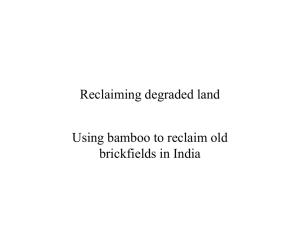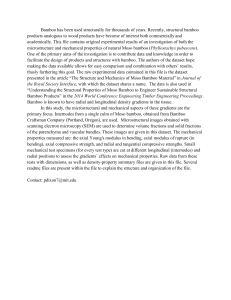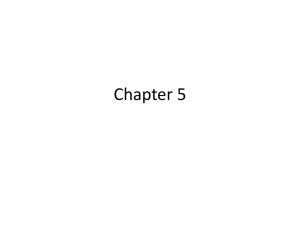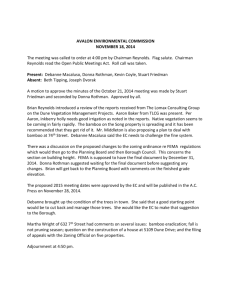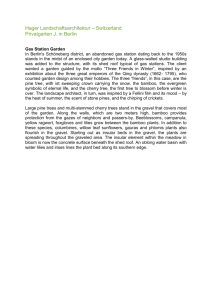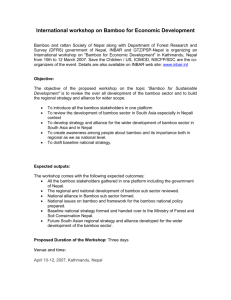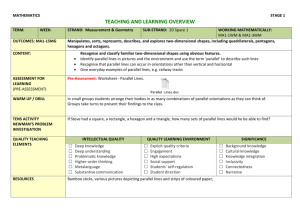Bamboo, Rattan and the UN Framework Convention on Climate
advertisement
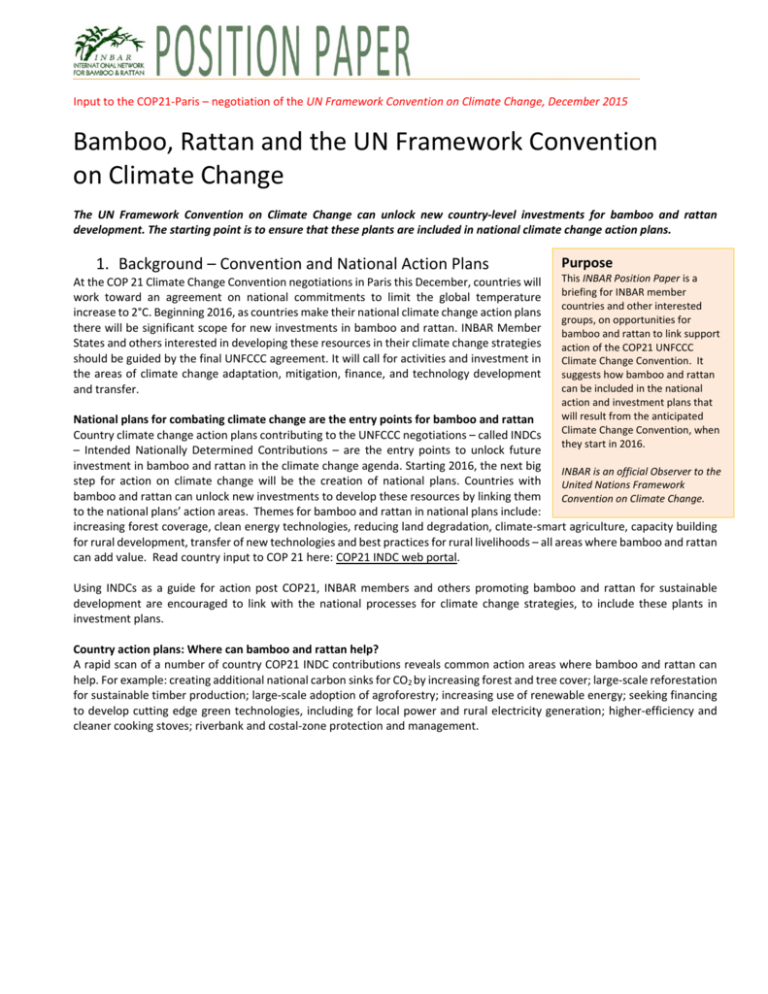
Input to the COP21-Paris – negotiation of the UN Framework Convention on Climate Change, December 2015 Bamboo, Rattan and the UN Framework Convention on Climate Change The UN Framework Convention on Climate Change can unlock new country-level investments for bamboo and rattan development. The starting point is to ensure that these plants are included in national climate change action plans. 1. Background – Convention and National Action Plans At the COP 21 Climate Change Convention negotiations in Paris this December, countries will work toward an agreement on national commitments to limit the global temperature increase to 2°C. Beginning 2016, as countries make their national climate change action plans there will be significant scope for new investments in bamboo and rattan. INBAR Member States and others interested in developing these resources in their climate change strategies should be guided by the final UNFCCC agreement. It will call for activities and investment in the areas of climate change adaptation, mitigation, finance, and technology development and transfer. Purpose This INBAR Position Paper is a briefing for INBAR member countries and other interested groups, on opportunities for bamboo and rattan to link support action of the COP21 UNFCCC Climate Change Convention. It suggests how bamboo and rattan can be included in the national action and investment plans that will result from the anticipated Climate Change Convention, when they start in 2016. National plans for combating climate change are the entry points for bamboo and rattan Country climate change action plans contributing to the UNFCCC negotiations – called INDCs – Intended Nationally Determined Contributions – are the entry points to unlock future investment in bamboo and rattan in the climate change agenda. Starting 2016, the next big INBAR is an official Observer to the step for action on climate change will be the creation of national plans. Countries with United Nations Framework bamboo and rattan can unlock new investments to develop these resources by linking them Convention on Climate Change. to the national plans’ action areas. Themes for bamboo and rattan in national plans include: increasing forest coverage, clean energy technologies, reducing land degradation, climate-smart agriculture, capacity building for rural development, transfer of new technologies and best practices for rural livelihoods – all areas where bamboo and rattan can add value. Read country input to COP 21 here: COP21 INDC web portal. Using INDCs as a guide for action post COP21, INBAR members and others promoting bamboo and rattan for sustainable development are encouraged to link with the national processes for climate change strategies, to include these plants in investment plans. Country action plans: Where can bamboo and rattan help? A rapid scan of a number of country COP21 INDC contributions reveals common action areas where bamboo and rattan can help. For example: creating additional national carbon sinks for CO2 by increasing forest and tree cover; large-scale reforestation for sustainable timber production; large-scale adoption of agroforestry; increasing use of renewable energy; seeking financing to develop cutting edge green technologies, including for local power and rural electricity generation; higher-efficiency and cleaner cooking stoves; riverbank and costal-zone protection and management. 2. COP 21 Convention themes linked to bamboo & rattan This section reviews the main thematic areas of the draft negotiating text in relation to bamboo and rattan. (D) Section on: Climate Change Mitigation Climate change mitigation refers to efforts to reduce or prevent emission of greenhouse gases, including using new technologies and renewable energies, making older equipment more energy efficient, or changing management practices or consumer behavior (UNEP). Examples: Societies can respond to reducing the effects of climate change by reducing greenhouse gas emissions and enhancing sinks and reservoirs, such as: the planting of new forests, the sustainable management of forests and enhancement of forest carbon stocks to reduce emissions; increasing renewable energy and reducing dependence on fossil fuels. Policies and instruments are available to governments to create the incentives for mitigation action. INBAR COMMENT Entry points for bamboo and rattan: Bamboo and Rattan as sustainable replacements for higher carbon emission materials In many cases, bamboo and rattan are viable replacements for higher carbon emission material for products made from wood, plastics and steel. Bamboo poles, fibre and engineered bamboo can be used for most purposes where timber is used and for many products made from plastic and steel. Bamboo is a “woody grass”, not a tree and is selectively harvested without harming the ecosystem, or contributing to deforestation. Rattan grows in forests and is being used for a growing number of products. Communities with steady rattan earnings will protect the trees to protect their income from these materials. In its cultivation and production life cycle, no part of the bamboo plant is wasted. Shoots are harvested for food; branches for poles that are used for many applications; the main bamboo pole for fibres for pulp or charcoal production and the lower trunk for construction uses or flooring and engineered bamboo products. Product Lifecycle Assessment shows that the production, transport and disposal cycle for bamboo flooring, decking and beam products made from bamboo in China and sold in Europe are carbon negative. While a specific assessment is needed for each product, bamboo generally compares favorably to European soft wood and performs better that tropical hard wood (Van der Lugt & Vogtländer, 2015). Laminated bamboo products have a lower carbon footprint than sandwich board Sustainable Development Goal 12- Ensure sustainable consumption and production patterns. INBAR COMMENT Entry points for bamboo and rattan: Bamboo for carbon sinks Like other plants, bamboo and rattan also absorb CO2. Research in China, for example, has shown that a managed forest of Moso bamboo forest absorbs more CO2 than an equivalent woodlot of Chinese fir. Unlike trees, bamboo is harvested selectively (in the case of Moso, only >3-4 years old culms are cut) and continues to store carbon for a longer term. Once products are made from bamboo, the carbon is locked up and is prevented from escaping into the atmosphere for the product lifetime. Bamboo therefore provides a secure carbon sink. Bamboo forests absorb and hold as much carbon as similar fast growing trees, such as Chinese fir and Eucalyptus. The carbon stored in Chinese bamboo forests is projected to increase from 727 million tonnes in 2010 to 1,018 million tonnes in 2050, or by nearly 40% in 40 years (Anon, 2014a). Sustainable Development Goal 13 - Take urgent action to combat climate change and its impacts. Renewable energy: Bamboo’s contribution Especially in the many tropical countries where it grows abundantly, bamboo should be considered as an important component of national and local green energy and climate change mitigation plans. In other locations, business models are emerging for the creation of bamboo plantations that provide a steady source of renewable fuel for charcoal production (avoiding deforestation), or small-scale electricity generation. Bamboo provides energy when it is burned as firewood, processed into chips or pellets, or carbonized as charcoal. Recent studies in China, Ethiopia and Ghana reveal that the calorific value of bamboo charcoal is similar to that of the most suitable woods currently used for charcoal. At an industrial scale, bamboo can be used to fire generators and power stations. Research is progressing on the viability of establishing bamboo plantations to supply biomass for power generation. There is also unexplored potential to use bamboo to produce liquid fuels. If viable, a bamboo bio-fuel value chain would use managed bamboo stands to provide a long-term, sustainable source of raw material for bio-energy, that would help reduce deforestation. Composition and calorific values of charcoal produced from bamboo and other commonly used sources of biomass in Ethiopia (Seboka & Duraisamy, 2008) Sustainable Development Goal 7 - Ensure access to affordable, reliable, sustainable, modern energy for all. INBAR COMMENT Entry points for bamboo and rattan: Bamboo and Rattan for forest expansion, management and land restoration Bamboo can play a strategic role in national forest expansion plans and for countries’ Reducing Emissions from Deforestation and Degradation (REDD+) programmes that will create new carbon sinks. Bamboo’s robust nature and rapid growth rate – thriving and expanding on severely degraded soils and reaching maturity in 3-6 years – make it an ideal pioneer species to reforest and rehabilitate lands quickly, as part of a longer-term forest expansion plan. Also, as bamboo is a grass not a tree, when it is cut, its root system remains and it regrows, continuing to sequester carbon. For land restoration, as part of a national re-greening or forest expansion plan, bamboo is used in the world’s developing regions to rapidly restore severely degraded landscapes. With its 1250 species, bamboo offers a range of characteristics for different uses. It thrives in temperate or tropical climates and has varieties that are ‘clumping’ – growing around a central plant clump; or ‘running’ – with rapidly spreading root systems. As it grows rapidly, regenerates annually and has very good adoption to poor soil or climate conditions, helping to bind soil bamboo is a unique and effective tool to control erosion and slope stability. A number of countries use bamboo along river banks to maintain slope stability and restrain erosion. In forest areas where rattan grows, it also gives a strong incentive for forest conservation. For REDD and sustainable management generally, rattan brings people new income sources from forests, creating a local economic incentive not to cut trees harvest wood – many communities that earn a good living from rattan are careful to maintain trees where it grows, to protect their income. Rattan also has growing potential as replacement for other embodied energy materials, including plastics and wood. Bamboos mature in 3-6 years. Some species grow rapidly and can cover expanses of barren land in that time. Bamboo is now part of a land rehabilitation action in 96 villages in Allahabad, India, helping restore productivity to 786,000 residents (Anon, 2014b). Sustainable Development Goal 13 - Take urgent action to combat climate change and its impacts. Sustainable Development Goal 15 - Protect, restore and promote sustainable use of terrestrial ecosystems, sustainably manage forests, combat desertification, and halt and reverse land degradation and halt biodiversity loss. (E) Section on: Climate Change Adaption Adaptation to climate change requires adjustments in ecological, social, or economic systems to respond to actual or expected climatic situations and their effects. Adapting includes changes in processes, practices, and structures to moderate potential damages or benefit from opportunities linked to climate change. (UNFCCC) Examples: Rural communities across the Global South are faced with changing and unpredictable weather patterns. The effects are seen in drought or unpredictable rainfall, increases in rain or flooding, erosion of farmlands. To address these, ‘climatesmart’ approaches are needed to preserve ecosystems and build resilience for communities, and sharing knowledge on new approaches and strengthening capacity of rural communities. INBAR COMMENT Entry points for bamboo and rattan: Climate-smart agriculture – innovative uses with bamboo and Rattan Bamboo is a powerful tool that communities can use to help reduce soil erosion, maintain slope stability and rapidly restore degraded lands. As bamboo grows rapidly, regenerates annually and has very good adaptation to poor soil or climate conditions, helping to bind soil. It is an ideal pioneer crop to regenerate damaged soils in preparation for future agricultural development. In one example from, Allahabad in India, the NGO, Utthan, has spread the benefits of bamboo-based land restoration to some 800,000 people in 80 villages, using this plant to return damaged lands to productive use and rebuilding a diverse agricultural livelihood system. As ecosystems are affected by climate change that can negatively affect traditional livelihood activities, both rattan and bamboo can help bring families new off-farm sources of income. For the most vulnerable communities these plants can help populations cope with potential ‘climate shocks’. Other climate-smart farming applications of bamboo are now being tested. One that has vast potential to benefit smallholder farmers, especially those living on marginal lands, is bamboo feed and fodder. As it grows easily in difficult climatic conditions, bamboo can provide a perennial source of animal fodder to villagers – one that grows the year round. Bamboo leaves are also a good source of nutrients, enriching soil throughout the year where they grow. For landscape restoration, bamboo adds 15 – 20 cm of humus to the soil each year and in ten years bamboo can increase the carbon content of the soil from zero to 0.7-0.9t/ha and reduce the pH from 10 to 6 (Anon, 2014b). Sustainable Development Goal 15 - Protect, restore and promote sustainable use of terrestrial ecosystems, sustainably manage forests, combat desertification, and halt and reverse land degradation and halt biodiversity loss. Disaster Resilience – the case for bamboo housing and structures Climate induced disasters include floods, typhoons and cyclones, rising sea levels, mud slides and degraded coastal zones. Rural communities and their farmlands are affected by these events, as are their dwellings. Bamboo construction is relatively little known in many areas. In others, such as South America, it is very well developed. Here, a culture of bamboo building traditions, practices and technologies, has evolved in response to communities’ needs for a safer place to live in the face of frequent natural events. For affordable housing and dwellings that can be rapidly erected to respond to natural disasters, bamboo is emerging as a flexible construction material of choice. A growing number of documented cases provide evidence of how bamboo structures better withstand natural disasters, than concrete housing, which is largely destroyed by floods, landslides or earthquakes. Bamboo’s unique properties of being sustainable and with high tensile strength, point to a revolution that is waiting to happen. Bamboo can be specified as part of a rural development and climate smart agriculture adaptation package that brings important livelihoods benefits to communities. A traditional bamboo shelter typically costs $1,500 to build and needs to be replaced every 5 years. New-technology homes promoted by INBAR and its partners cost $4,000 in Ecuador and $5,000 in Peru and last 30 years, saving 30% of construction costs over the long term. In Ecuador, it is estimated that almost 2 million people live in poor quality bamboo shacks that are vulnerable to extreme weather events. New affordable modern designs of bamboo house components can help reduce the risks (Anon, 2014c). Sustainable Development Goal 11 - Make cities and human settlements inclusive, safe, resilient and sustainable. (G) Section on: Finance Local, national or transnational financing is critical to addressing climate change, as large-scale investments are required to significantly reduce emissions, especially in sectors emitting large quantities of greenhouse gases. Climate finance is equally important for adaptation, where significant financial resources are needed for countries to adapt to and reduce the effects of climate change. (UNFCCC) Examples: Approaches and technologies for investing in green energy, divesting fossil fuel investments and development of local and national green energy plans. INBAR COMMENT Entry points for bamboo and rattan: Countries can specify climate smart investments in national action plans that use the bamboo and rattan approaches and interventions described in the other sections of this briefing. (H) Section on: Technology Development and Transfer Promoting development and transfer of environmentally sound technologies is critical in enabling developing countries to pursue their objectives for climate-friendly sustainable development. The Convention encourages countries to take all practicable steps to promote, facilitate and finance, the transfer and access to, environmentally sound technologies and know-how to others, particularly in developing countries, to enable them to implement the Convention (UNFCCC). Examples: This section covers green power and transport. Adaptation measures taken by local farmers include new crop varieties, models, site-specific management techniques, and low-carbon/low-water production systems. Engaging local farmers also ensures adaptation efforts are more likely to be successful. INBAR COMMENT Entry points for bamboo and rattan: A number of countries, such as China, have well-developed bamboo sectors and technologies. Indonesia is a leader in rattan development. Many bamboo and rattan resource countries in the Global South are eager to develop their sectors and apply related climate smart activities in their local context, in national sustainable development plans. INBAR programmes to build capacity and share knowledge and practices between countries can help and have been progressing for two decades. The Global Assessment of Bamboo and Rattan (GABAR), the initiative of INBAR and its 41 Member countries, is building a broader learning partnership where all actors with expertise and an interest in bamboo and rattan development can share evidence and knowledge. Many of the technologies and approaches in the GABAR knowledge base will national climate change action, directly or indirectly. All countries are encouraged to participate. References Anon, 2014a. Bamboo: A strategic resource for countries to reduce the effects of climate change. Policy paper 1. INBAR, Beijing, China Anon, 2014b. Greening Red Earth. Restoring Landscapes, rebuilding lives. Bamboo’s role in the environmental and socioeconomic rehabilitation of villages devastated by brick mining. 2nd edn. INBAR, Beijing, China. Anon, 2014c. Vulnerability of bamboo housing to climate change in the coast of Ecuador – English summary of Spanish report. INBAR, Quito, Ecuador. Seboka, Y. & Duraisamy, J. 2008. Charcoal supply chain study in Ethiopia. In: Kwaschik (ed). Proceedings of the “Charcoal and communities conference in Africa”, 16-18 June 2008, Maputo, Mozambique. Van der Lught, P. & Vogtländer, J.G. 2015. The Environmental Impact of Industrial Bamboo Products: Life-Cycle Assessment and Carbon Sequestration. 2nd edn. Working paper 35. Beijing, China.
